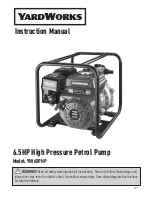
ALF-12030-E-02
All-Flo
13
OPERATION
The Air-Operated Double Diaphragm Pump requires
a minimum of 20 psig of air to operate, with some
variation according to diaphragm material. Increasing
the air pressure results in a more rapid cycling of the
pump and thus a higher liquid flow rate. In order to not
exceed 120 psig of inlet air pressure, and for accurate
control of the pump, it is suggested to use a pressure
regulator on the air inlet.
An alternate means of controlling the flow-rate of the
pump is to use an inlet air valve and partially open or
close accordingly. When the air valve is completely in
the closed position, the pump will cease to operate.
A third method of controlling the flow rate of the
pump is to use a liquid discharge valve. Closing the
liquid discharge valve will cause a decrease in the
flow rate since the pump will operate against a higher
discharge pressure.
Solenoid control of the inlet air may also be used in
order to facilitate remote operation. A three way
solenoid valve is recommended, in order to allow the
air to “bleed off” between the solenoid and the pump.
Do not use valves for flow control on the suction side
of the pump. (Closing or partially closing a liquid
suction valve restrict the suction line and may cause
damage to the diaphragms.) Suction strainers may
be employed to reduce or eliminate larger solids, but
routine maintenance is necessary in order to prevent
a restriction on the suction.
MAINTENANCE
Due to the unique nature of each application, periodic
inspection of the pump is the best method to determine
a proper maintenance schedule. A record should be
kept of all repairs made to an installed pump. This will
serve as the best predictor of future maintenance.
Typical maintenance involves replacing of “wear-
parts” such as the diaphragms, balls, valve seats and
O-rings. Proper maintenance can ensure trouble-free
operation of the pump. Refer to repair and assembly
instructions for further details.
WARNING
Maintenance must not be performed
when a hazardous atmosphere is present.
WARNING
For pump models with non-metallic
manifolds, air valves, or chambers: When the relative
humidity in the surrounding atmosphere is above 30%,
the equipment must not be touched by personnel
unless first wiped down with a damp cloth.
MAINTENANCE SCHEDULE
WEEKLY (OR DAILY)
Make a visual check of the pump. If pumped fluid is
leaking out of the pump, pipe fittings or muffler turn
off pump and schedule maintenance.
EVERY THREE MONTHS
Inspect fasteners and tighten any loose fasteners to
recommended torque settings.
Schedule pump service based on pump’s service
history.














































